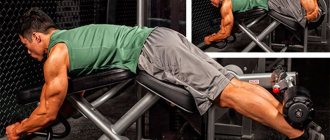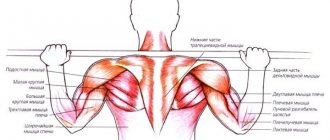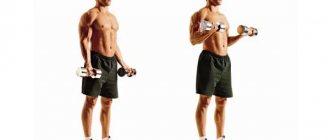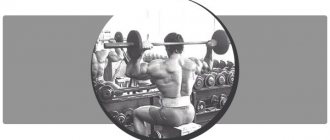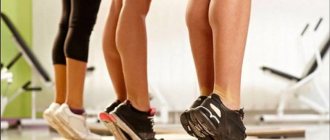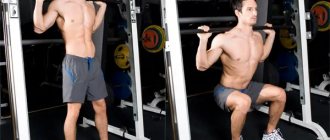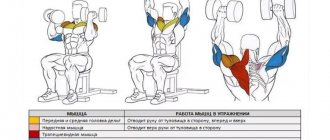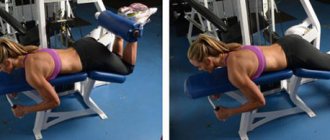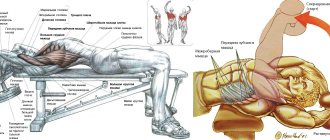The calf raise exercise in the leg press machine pumps up the bottom and inner side of the calf muscle. Emphasizes the bottom of the calf muscle. Formative exercise.
Calf raises on a leg press machine “trim” the bottom of the calf muscle and highlight the inside of the calf muscle, making the calf look much fuller when viewed from behind.
Ankle flexion is a key movement in race walking, running and jumping, as it is the lifting on the balls of your feet and pushing off the ground that gives the body the final impulse that propels it forward or upward. For example, in running or race walking, up to 50% of the total effort of all muscles pushing the body forward falls exclusively on the muscles of the back of the lower leg. That is why the strength of these muscles is extremely important in all sports that involve running, jumping and fast leg movements.
Calf raises in the leg press machine - an exercise for the leg muscles
What muscles work
The calves work anyway in squats, deadlifts and lunges, but they need isolation exercises when it comes to lack of volume. The load in the toe press is isolated in nature. If, for example, during any calf raise we also engage the press for stabilization, and the back muscles if we hold the weight on it, then here we avoid this by working only through the calves.
The load is evenly distributed between:
- Calf muscles;
- Soleus muscles
Thus, both the outer and “inner” layers of muscles are worked out in this exercise. The movement itself resembles a simple rise on the toes and is anatomically natural. An athlete of any level cannot have any problems with it.
Hand position and grip in the bench press
Just like foot position, hand position is very individual and depends on various factors such as anatomy, shoulder injuries, wrist mobility, etc. There are three main types of grip: neutral, narrow and wide.
Neutral grip
Narrow grip
Wide grip
Most people choose a close or neutral grip. The wider the grip, as a rule, the more the chest muscles are pumped.
However you decide to hold the barbell, you should also make sure that your wrists are in a neutral position and not arched, as this puts a lot of tension on them.
It is also very important to hold the bar as tightly as possible and press your thumb and palm firmly against it. This will reduce the strain on your wrists and prevent them from arching. The knuckles of your other 4 fingers should be behind the bar, not under it.
The video at the end will help you reinforce the correct technique.
The knuckles of your other 4 fingers should be behind the bar, not under it. The video at the end will help you reinforce the correct technique.
Pros of exercise
The most significant is exclusion from the working chain of the spinal column. This gives athletes who have suffered a serious spinal injury a chance to still build muscle. There is no load on the lower back, and no impact on the trapezius as when performing a lift with a barbell. The movement is completely natural and can be performed by any beginner.
How does the toe press affect muscles:
- The calves become denser;
- A relief appears;
- Strength and power-speed characteristics are improved;
- Increases performance in squats due to improved amplitude and stabilization;
- Movement helps prevent tendon injuries
Important points to pay attention to
The technique of any exercise has its secrets that will help you avoid injury and achieve the desired results. The leg press is no exception. So, consider a few important points that will help when performing the press.
Your feet should be firmly pressed against the platform to reduce the load on the spine. If the entire foot is not under control, take a break and be distracted by another exercise. Start only when you are focused on your feet;
The platform is squeezed out with the heels. There is no need to overpower yourself and press your fingers into the platform - this will do nothing but harm. The correct execution of the exercise is to press with the foot and press with the heel, then it will become much easier to do it;
The knees are directed parallel to the feet. When the hips deviate outward or inward, the quadriceps does not work and smaller muscles become tense;
By lowering the platform, you need to move towards the ideal - ninety degrees of bend at the knee. But if your legs are not yet holding the platform in this position, you should not continue, because The depth of the bench press is very individual. And if the neighbor in the hall did this exercise correctly, this does not mean that everyone can do it. After a few practices, you can achieve the correct position without effort;
Try to get double benefits from the machine - when squeezing the platform upward, tense your lower abdominal muscles - this is a great way to pump them up;
Keep your head on the headrest and don’t lift it, don’t talk to other visitors to the gym, don’t turn around towards the noise - stay focused on the exercise;
Proper breathing will help make leg presses easier. It’s difficult to establish breathing the first time you perform a bench press - gym goers are so focused on squeezing the platform that they forget to breathe altogether
It is important to remember that oxygen plays a key role in the body, and during physical activity it is doubly necessary. Therefore, you need to accustom yourself to such a rhythm - when squeezing the platform, you exhale, and when lowering, you inhale;
The under-seat grab handles aren't meant to be forgotten.
When pressing with your hands, you need to tightly squeeze the handrails, which will relieve the lower back;
Try to go through the entire amplitude. Even if it becomes difficult, and you don’t have the strength to squeeze the platform, it is better to break the exercise into more approaches with fewer repetitions, but do these approaches with high quality;
It is better to start the bench press without canopies, idle. After the muscles get used to the weight of the platform itself, then you can add kilograms;
If you feel that your strength is on the verge and you can no longer squeeze the platform, do not throw it suddenly. Smoothly lower the platform, bend the lock and the platform will return to its original position. Otherwise, you can injure your legs, even if the lock of the machine is bent.
Exercise technique
It is important to position yourself correctly in the machine so that your back does not feel any stress at all. You need to sit on the seat of the exercise machine, adjusting it so that it is convenient to remove the platform due to the access to the toes. The knees should be straight or slightly bent.
The technique itself looks like this:
- Take the starting position, rest your toes on the platform hip-width apart;
- Push the platform away from you, stepping out on your toes;
- Remove the safety handles;
- Perform platform presses for the required number of repetitions;
- Return the belays and complete the approach.
Usually, for a beginning athlete, only 15-20 repetitions in 3-4 sets are enough to create growth stimuli for the calves. But there are also individual situations. If an athlete has good endurance naturally, they may have problems with this exercise. It may not provide the necessary stimulus for growth, and then additional repetitions will have to be included.
Important: this movement is not performed with force. It is always worked in a multi-repetition mode until failure, or to a state close to failure. Calves cannot be pumped up in a power mode due to the peculiarity of their anatomical role.
Toe press in the simulator
Advantages and disadvantages of this exercise
It may seem that since the exercise is popular and many people recommend it, then it should have only advantages. Yes, I agree they exist and this:
- The ability to detail the quadriceps and give them an expressive shape.
- An opportunity to finish off your quadriceps if you no longer have the strength to do heavy basic exercises.
- With the correct technique, extension can strengthen the knee ligaments.
- And of course, it provides isolated work on all 4 quadriceps muscles.
But in addition to all these advantages, you must take into account that this exercise is extremely dangerous for your knees! Cruciate ligaments are especially at risk
.
They prevent the knee joint from moving forward and backward, as well as in and out. That is, during strong extension of the knee with a fixed pelvis (which is what happens in this exercise), these ligaments are very stretched. Or rather, one of them is the front one. This may lead to its rupture. Yes, it can be treated, but for me it’s not worth it. And after such an operation, you are unlikely to be able to continue your training with the same intensity. Especially for beginners, doing this exercise does not make any sense.
After all, you can’t build muscle mass with extensions! Why am I telling you all this? Because it is very important to me that you have an understanding and are aware of all the risks before you start doing leg extensions in the machine. And knowing this, you will already decide whether it is worth exposing your knees to such danger.
But still, exercise can bring not only injuries, but also benefits. The main thing is to know when to do it and avoid making serious mistakes. The most important thing is to do everything with the right technique.
Bench Press Strength Training Program
The program is presented in the form of a cycle, at the end of the last workout we move on to workout No. 1, working approaches are indicated without taking into account warm-up ones.
A mandatory factor before performing a bench press is a preliminary warm-up:
general warm-up of the whole body – 5 minutes
for the bench press: warm-up of the shoulder joints - triset: Cuban press with dumbbells while standing (l-fly flyes with dumbbells), dumbbell flyes to the sides while standing, raising dumbbells in front of you, all three exercises are performed one after another without rest, weight of dumbbells - 1-5 kg, 15 repetitions in each exercise
triceps on the block – 1 set warm-up light weight for 30 repetitions
for squats: bike 10 minutes, warm up the knee joints and squats with your own weight 30 times one set
for Romanian deadlifts: hyperextension without weight for 30 reps, one set
Workout 1 – Heavy Bench Press
- Bench press – 3x6
- Dips – 1x20 without weight, 2x10-12 with additional weight
- Pull-downs or wide-grip pull-ups – 3x10-12
- Barbell curl for biceps – 3x12
- Press – 3xmax
2 days rest
Workout 2 – Heavy Romanian Deadlifts and Barbell Squats
- Barbell squats – 3x8
- Romanian barbell deadlift – 3x6
- Hyperextensions – 1x20-25 with or without weight
- Calf raise – 3x15-20
- L-fly dilutions at the block – 1x20, 1x15, 1x12
- Press – 3xmax
2 days rest
Workout 3 – Light Bench Press
- Bench press – 3x12
- Triceps on the block – 2x20-25
- Upper pulley to chest – 3x12-15
- Barbell curls for biceps – 3-4x12
- Press – 3xmax
2 days rest
Workout 4 – Light Romanian Deadlifts and Barbell Squats
- Barbell squats – 3x15
- Romanian barbell deadlift – 3x15
- Hyperextensions – 1x20-25 with or without weight
- Calf raise – 3x15-20
- L-fly fly with dumbbell lying – 1x20, 1x15, 1x12
- Press – 3xmax
2 days rest
Workout 5 – Heavy Bench Press
- Bench press – 3x1-3
- Dips – 1x20 without weight, 2x10-12 with additional weight
- Horizontal hummer row or dumbbell row - 3x10
- Dumbbell curls for biceps or hammer – 3x12
- Press – 3xmax
2 days rest
Workout 6 – Heavy Romanian Deadlifts and Barbell Squats
- Barbell squats – 3x8
- Romanian barbell deadlift – 3x3-5
- Hyperextensions – 1x20-25 with or without weight
- Calf raise – 3x15-20
- L-fly dilutions at the block – 1x20, 1x15, 1x12
- Press – 3xmax
2 days rest
Workout 7 – Light-Speed Bench Press
- Bench press – 8x3 (weight 45-55% of maximum)
- Triceps on the block – 2x20-25
- Horizontal hummer row or dumbbell row to the belt – 3x12-15
- Barbell curls for biceps – 2-3x20
- Press – 3xmax
2 days rest
Workout 8 – Light Romanian Deadlifts and Barbell Squats
- Barbell squats – 3x15
- Romanian barbell deadlift – 3x15
- Hyperextensions – 1x20-25 with or without weight
- Calf raise – 3x15-20
- L-fly fly with dumbbell lying – 1x20, 1x15, 1x12
- Press – 3xmax
2 days rest
Workout 9 – Medium Bench Press
- Bench press – 3x8-10
- Dips – 1x20 without weight, 2x10-12 with additional weight
- Horizontal hummer row or dumbbell row - 3x10
- Barbell curl for biceps – 3-4x10-12
- Press – 3xmax
2 days rest
Workout 10 – Medium Romanian Deadlifts and Barbell Squats
- Barbell squats – 3x8-10
- Romanian barbell deadlift – 3x8-10
- Hyperextensions – 1x20-25 with or without weight
- Calf raise – 3x15-20
- L-fly dilutions at the block – 1x20, 1x15, 1x12
- Press – 3xmax
2 days rest
Workout 11 – Light Bench Press
- Bench press – 3x12
- Triceps on the block – 2x20-25
- Upper pulley to chest – 3x12-15
- Barbell curl for biceps – 3x12
- Press – 3xmax
2 days rest
Workout 12 – Light Romanian Deadlifts and Barbell Squats
- Barbell squats – 3x12
- Romanian barbell deadlift – 3x15
- Hyperextensions – 1x20-25 with or without weight
- Calf raise – 3x15-20
- L-fly fly with dumbbell lying – 1x20, 1x15, 1x12
- Press – 3xmax
2 days rest and move on to: Workout 1 – heavy bench press
Recommendations for implementation
There are several simple techniques that will help you load the quadruple major thigh muscles in a new way. It's about:
Full and partial amplitude. If we fully extend the leg, then the load falls more on the broad medial head. But if we work with a little more weight in a partial amplitude. That is, extend your leg halfway. Then the direct and intermediate heads will be involved in the work. When using partial amplitude, you will need to tilt the back slightly back. This will stretch these heads more.
Turning the feet. The position of our legs also determines which head will receive the most load. If you turn your feet inward towards each other. This will stretch the lateral head more, and it will be used more than the others. Turning your toes to the sides will shift the emphasis to the medial head.
One leg extension. This is a more professional technique, beginners do not need it
Performing an extension with one leg, it is easier to focus on the work of the hip. Also, using this exercise, you can reduce the imbalance in the development of the quadriceps of each leg.
You can try each of these techniques. The main criterion should be the correct execution technique. So work on it before making these kinds of changes to the exercise.
Contraindications
Persons diagnosed with protrusion or hernia of the lumbar spinal column should refuse to perform bench presses in the simulator, replacing it with a more gentle load. If you have scoliosis or kyphosis, the exercise can be performed, but it is strongly recommended to do it using small weights and an athletic belt. It is best to focus on the press option, which is done with two legs.
Sports doctors do not recommend choosing this variety for people with knee diseases. Violating the ban can cause irreversible problems. Also, exercise is prohibited for those who were injured several years ago. Especially if it was a torn knee ligament. Expect full recovery. Huge weights can also reignite relapse.
Weight and reps for beginners
To achieve a visual effect, that is, enlargement and rounding of the buttocks, for women the optimal number of leg presses in the simulator will be 12-15 times with a weight of 100 kg or more. But this does not mean that you should immediately take on heavy loads from the first workout.
To begin with, you should do the exercise with a light weight, but with a large number of repetitions. For example, 40 kg for 25 repetitions. However, you can then gradually increase the load in weight, but decrease in repetitions, setting your goal to 100 kg for 15 repetitions.
Important to remember! Before your first session on the simulator, you need to start by raising and lowering an empty platform without weight in order to understand the technique. Then you can calculate your working weight and gradually increase the load
The first load on the legs should be minimal - with an empty platform
Increasing the load is an important component of the effectiveness of the exercise, since without effort the muscles simply will not begin to grow and will remain at the same level for a long time, even if the training is performed frequently with many approaches.
Recommendations: what to consider?
To summarize, it is worth saying that the vertical press has a fundamentally different load vector, which has its own advantages and disadvantages. The knees do not fall towards the shoulders, but towards the stomach.
Because of this, the movement is almost identical to classic squats. Most of the load falls on the quadriceps brachii muscle.
Here are some recommendations on how to increase the effectiveness of the exercise and get results from it:
If you choose a wide stance, make sure you have the correct technique. Of course, it is very tempting to shift the load to the hamstrings and glutes in the vertical press. However, a small technical mistake can become traumatic for the lower back, since if performed incorrectly, it will come off the bench.
It is recommended to place the leg press at the very beginning of the workout. Either after squats, or instead of them. In the end, there will simply be no strength for basic movement.
The vertical leg press is not an exercise you can experiment with to pre-fatigue.
Choose a comfortable weight. There is no need to conduct strength experiments - this is the lot of professionals
It is important to work the muscle technically and correctly. Therefore, you need to increase weight gradually, without harm to yourself.
Careful motion control
During the exercise, it is important to feel every muscle. This will not only allow for quality work on the target group, but will also establish a neuromuscular connection, which will be very useful in the future.
